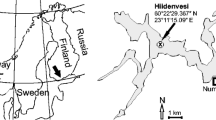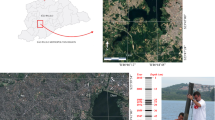Abstract
Ongoing monitoring programs and historical data are not sufficient to establish anthropogenic effects on the ecology of Chesapeake Bay. However, stratigraphic records preserved in the sediments can be used to reconstruct both prehistoric and historic sedimentation and water conditions of the bay, including anoxia and eutrophication. Pollen, diatoms, total organic carbon (TOC), nitrogen, total sulfur, and an estimate of the degree of pyritization of iron (DOP) are being used as paleoecological indicators in dated sediment cores for the purpose of reconstructing a long-term environmental history of the bay. Analysis of the data indicates that sedimentation rates, anoxic conditions, and eutrophication have increased in the Chesapeake Bay since the time of European settlement. For example, since initial land clearance around 1760, sedimentation rates have increased from as low as 0.02 cm yr−1 to an average 0.22 cm yr−1, and TOC from 0.14 mg cm−2 yr−1 to a high 4.96 mg cm−2 yr−1. Diatom community structure shows a steady decrease in overall diversity since 1760 and the centric:pennate ratio has increased significantly since 1940.
Similar content being viewed by others
Literature Cited
Battarbee, R. W., R. G. Scaife, andS. J. Phethean. 1985. Chapter 10. Palaeoecological evidence for sea-level change in the Bann estuary in the Early Mesolithic period, p. 111–120.In Excavations at Mount Sandel 1973–77, County Londonderry. Her Majesty’s Stationery Office, Belfast.
Battarbee, B. W., J. P. Smol, andJ. Meriläinen. 1986. Diatoms as indicators of pH: An historical review, p. 5–15.In J. P. Smol, R. Battarbee, R. B. Davis, and J. Meriläinen (eds.), Diatoms and Lake Acidity. Dr. W. Junk Publishers, Dordrecht.
Batiuk, R. 1987. Chesapeake Bay Mainstem and Tributary Monitoring Program, p. 12–17.In G. B. MacKiernan (ed.), Dissolved Oxygen in the Chesapeake Bay: Processes and Effects. Maryland Sea Grant, College Park, Maryland.
Berner, R. A. 1980. A rate model for organic matter decomposition during bacterial sulfate reduction in marine sediments.Colloques Internationaux du Centre National de la Recherche Scientifique 293:35–44.
Birks, H. J. B., andH. H. Birks. 1980. Quarternary Palaeoecology. University Park Press, Baltimore, Maryland. 289 p.
Brush, G. S.. 1986. Geology and paleoecology of Chesapeake Bay: A long-term monitoring tool for management.Journal of the Washington Academy of Science 76:146–160.
Brush, G. S. 1989. Rates and patterns of estuarine sediment accumulation.Limnology and Oceanography 34:1235–1246.
Brush, G. S. 1991. Stratigraphic history helps us understand today’s Chesapeake Bay.Geotimes 36:21–23.
Brush, G. S., andF. W. Davis. 1984. Stratigraphic evidence of human disturbance in an estuary.Quaternary Research 22: 91–108.
Brush, G. S., E. A. Martin, R. S. DeFries, andC. A. Rice. 1982. Comparisons of210Pb and pollen methods for determining rates of estuarine sediment accumulation.Quaternary Research 18:196–217.
Canfield, D. E. 1989. Reactive iron ini marine sediments.Geochimica et Cosmochimica Acta 53:619–632.
Cooper, S. R., andG. S. Brush. 1991. Long-term history of Chesapeake Bay anoxia.Science 254:992–996.
Crawford, R. M. 1979. Taxonomy and frustular structure of the marine centric diatomParalia sulcata.Journal of Phycology 15:200–210.
Funkhauser, J. W. andW. R. Evitt. 1959. Preparation techniques for acid insoluble microfossils.Micropaleontology 5(3): 369–375.
Goldberg, E. D., V. Hodge, M. Koide, J. Griffin, E. Gamble, O. P. Bricker, G. Matisoff, G. R. Holdren, Jr., andR. Braun. 1978. A pollution history of Chesapeake Bay.Geochimica et Cosmochimica Acta 42:1413–1425.
Hecky, R. E., andP. Kilham. 1973. Diatoms in alkaline, saline lakes: Ecology and geochemical implications.Limnology and Oceanography 18:53–71.
Hendey, N. I. 1964. An Introductory Account of the Smaller Algae of British Coastal Waters. Part 5: Bacillariophyceae. Her Majesty’s Stationery Office, London, 317 p.
Hendey, N. I. 1976. The species diversity index of some inshore diatom communities and its use in assessing the degree of pollution insult on parts of the north coast of Cornwall.Nova Hedwigia 54:355–378.
Lord, C. J., III andT. M. Church. 1983. The geochemistry of salt marshes: Sedimentary ion diffusion, sulfate reduction, and pyritization.Geochimica et Cosmochimica Acta 47:1381–1391.
Luther, G. W., III,T. M. Church, J. R. Scudlark, andM. Cosman. 1986. Inorganic and organic sulfur cycling in salt marsh pore waters.Science 232:746–749.
Malone, T. C. 1987. Seasonal oxygen depletion and phytoplankton production in Chesapeake Bay: Preliminary results of 1985–86 field studies.In G. B. MacKiernan (ed.), Dissolved Oxygen in the Chesapeake Bay: Processes and Effects. Maryland Sea Grant, College Park, Maryland.
Middleburg, J. J. 1991. Organic carbon, sulphur, and iron in recent semi-euxinic sediments of Kau Bay, Indonesia.Geochimica et Cosmochimica Acta 55:815–828.
Newcombe, C. L., andW. A. Horne. 1938. Oxygen-poor waters of the Chesapeake Bay.Science 88:80–81.
Officer, C. B., R. B. Gibbs, J. L. Taft, L. E. Cronin, M. A. Tyler, andW. R. Boynton. 1984. Chesapeake Bay anoxia: Origin, Development and significance.Science 223:22–27.
Palmer, C. M. 1969. A composite rating of algae tolerating organic pollution.Journal of Physiology 5:78–82.
Patten, B. C. 1962. Species diversity in net phytoplankton of Raritan Bay.Journal of Marine Research 20:57–75.
Patrick, R. 1967. Diatom communities in estuaries, p. 311–315.In G. H. Lauff (ed.), Estuaries. Publication #83, American Association for the Advancement of Science, Washington, D.C.
Patrick, R. 1977. Ecology of freshwater biatoms and diatom communities.In D. Werner (ed.), The Biology of Diatoms. University of California Press, Berkeley, California.
Raiswell, R., F. Buckley, R. A. Berner, andT. F. Anderson. 1988. Degree of pyritization of iron as a paleoenvironmental indicator of bottom-water oxygenation.Journal of Sedimentary Petrology, 58:812–819
Round, F. E., R. M. Crawford, andD. G. Mann. 1990. The Diatoms: Biology and Morphology of the Genera. Cambridge University Press. Cambridge. 747 p.
Schelske, C. L., D. J. Conley, E. F. Stoermer, T. L. Newberry, andC. D. Campbell. 1986. Biogenic silica and phosphorus accumulation in sediments as indices of eutrophication in the Laurentian Great Lakes.Hydrobiologia 143:79–86.
Seliger, H. H., J. A. Boggs, andW. H. Biggley. 1985. Catastrophic anoxia in the Chesapeake Bay in 1984.Science 228: 70–73.
Shannon, C. E., andW. Weaver. 1949. The Mathematical Theory of Communication. University of Illinois Press, Urbana, Illinois.
Sherman, J. W., andR. Patrick. 1981. The waters of Merom: A study of Lake Huleh 7. Diatom Stratigraphy of the 54-M Core.Archiv fur Hydrobiologie 92:199–221.
Stockner, J. G., andW. W. Benson. 1967. The succession of diatom assemblages in the recent sediments of Lake Washington.Limnology and Oceanography 12:513–532.
Taft, J. L., E. O. Hartwig, andR. Loftus. 1980. Seasonal oxygen depletion in Chesapeake Bay.Estuaries 3:242–247.
Vinyard, W. 1979. Diatoms of North America. Eureka Publishing Co., Inc., Eureka, California.
Washington, H. G. 1984. Diversity, biotic and similarity indices: A review with special relevance to aquatic ecosystems.Water Research 18:653–694.
Wilderman, C. C. 1986. Techniques and results of an investigation into the autecology of some major species of diatoms from the Severn River estuary, Chesapeake Bay, Maryland, U.S.A., p. 631–643.In M. Ricard (ed.), Proceedings of the 8th International Diatom Symposium. Koeltz Scientific Books, Koenigstein, Germany.
Author information
Authors and Affiliations
Rights and permissions
About this article
Cite this article
Cooper, S.R., Brush, G.S. A 2,500-year history of anoxia and eutrophication in Chesapeake Bay. Estuaries 16, 617–626 (1993). https://doi.org/10.2307/1352799
Received:
Accepted:
Issue Date:
DOI: https://doi.org/10.2307/1352799




